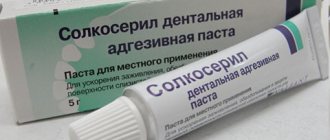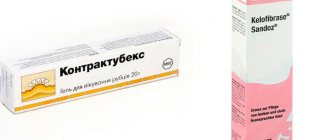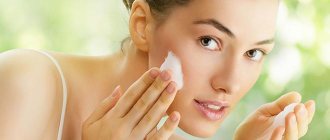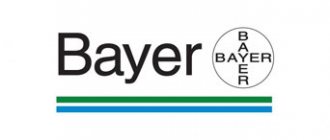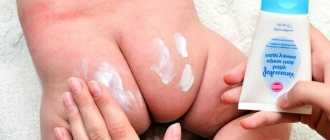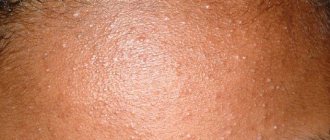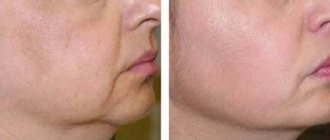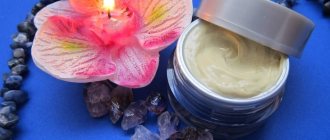Recently, all kinds of chemical peels to rejuvenate and eliminate skin imperfections have become a popular salon procedure. There is a lot of controversy surrounding this procedure; this type of peeling has many supporters and opponents, but with the right approach and choice of a cosmetologist, the result will be amazing.
In the fight for youthful skin, experts advise starting with superficial peeling, which includes glycolic peeling, and only then moving on to procedures that affect the middle and deep layers of the skin.
A glycolic peel is a type of superficial chemical peel using glycolic acid. Glycolic acid is a fruit acid with a short formula and is one of the simplest hydroxy acids. It is widely used in cosmetology as an active substance for exfoliating dead skin cells, as well as for the treatment of hyperkeratosis (severe thickening of the stratum corneum of the epidermis). Glycolic acid is highly soluble in water and alcohol.
This type of peeling is used to combat the first signs of skin aging or some of its shortcomings. Cosmetologists recommend doing it to clients over 15 years old. Glycolic peeling gently cleanses the skin of dead and keratinized particles, with virtually no trauma to it. Traces of the procedure disappear within a few days after it was done.
The essence of glycolic peeling for skin
The main component of the glycolic peeling preparation is natural fruit acid - glycolic. It gently affects the upper layer of the epidermis, burning out its dead layer (that is, the stratum corneum becomes smaller, but at the same time the living layer of the epidermis thickens, and thereby pigmentation decreases). This stimulates the renewal of skin cells, all irregularities, acne marks and shallow wrinkles disappear. The elasticity of the skin and its healthy color are also restored.
In short, peeling with glycolic acid starts the process of renewal and production of new collagen and elastin, and, as a result, removes fine wrinkles, evens out tone, improves skin texture, and also helps in the fight against acne.
What you need to know about post-acne peeling
Is it possible to get rid of post-acne?
Post-acne is scars or dark spots in places where there were acne. They indicate, on the one hand, the depth of skin damage and the strength of inflammation in a particular area. And on the other hand, about the lack of one’s own resource for self-healing. We have to interfere with the skin renewal processes and make them more intense with the help of peeling.
Mechanism of action
With the help of peeling under the supervision of a specialist, the surface layers of the skin are deliberately destroyed. Along with them, damage to these layers is also eliminated. Since in the case of post-acne they can be quite deep, then the impact is required to be deep. Although it all depends on the individual situation.
Indications for use
In addition to popular renewal and rejuvenation, peelings are used to combat hyperpigmentation and post-acne. Keep in mind: Just going to a salon to get rid of scars and blemishes won't work. A preliminary consultation with a doctor is required.
Your doctor will help you choose the appropriate type of peeling.
Indications for the procedure
Before contacting a salon for such a procedure, it is necessary to determine under what conditions this procedure is recommended. Indications include:
- signs of skin aging and loss of elasticity;
- dark spots;
- scars and bumps after acne;
- acne and redness;
- early wrinkles;
- skin photoaging;
- treatment of skin diseases caused by infection, for example, molluscum contagiosum.
The cosmetologist needs to assess the condition of your skin and determine the need for this cosmetic procedure. It should be noted that the peeling procedure using glycolic acid is aimed at improving the client’s appearance. However, for a sustainable effect, it is necessary to determine the cause of skin problems and act on them from the inside. In order not to harm the skin, after the procedure it is necessary to completely avoid the use of any cosmetics, visiting the sauna, bathhouse, sunbathing and exposure to the sun for several days.
TYPES OF FACIAL PEELING IN COSMETOLOGY
The process of exfoliation (or sloughing off damaged cells to improve appearance) could not always boast as many advantages as in the modern world.
Until doctors learned to control the depth of destruction of facial tissues and resist the penetration of bacteria, the first attempts brought mostly disadvantages. To make the skin peel off, it was burned with a hot iron or vinegar, as a result, instead of a miraculous transformation, scars, scars and suppuration appeared.
Fortunately, in the process of evolution, working types of peeling were finally found - chemical (exfoliation with acids or enzymes), mechanical (face polishing with brushes or scrubs), laser and others. The chemical method turned out to be the most popular due to its affordability and ease of implementation at home.
In addition to dividing according to exfoliation methods, peeling can also be classified according to the depth of penetration into the tissue. In this case, they talk about dividing into types such as superficial, middle and deep.
Surface technique
The gentlest exfoliation. It is carried out using enzymes (enzymes) from fruits or egg whites, as well as using AHA acids: glycolic, mandelic, lactic, etc., with a concentration of up to 25% of the active substance in the preparation.
Such measures are prescribed for beginners or as preparation for more serious cosmetic procedures. As a result, only the upper, keratinized layer of the epidermis, barely visible to the eye, is removed. As a result, barely noticeable wrinkles, pimples and age spots disappear.
Among the advantages of superficial peeling are:
- No pain;
- Quick results;
- Minimum side effects;
- Possibility of independent implementation;
- Rapid restoration of the epithelium.
However, even such a delicate procedure can have disadvantages:
- Mild, fine-plate peeling may occur;
- Suitable only for refreshing the skin; pronounced rejuvenation cannot be achieved;
- Due to the mild action, more procedures will be required, and accordingly, the price will be higher;
- You will need to find time for a full course of 5-8 sessions of 1 treatment weekly.
Middle technique
To carry out the procedure, a more concentrated (up to 50%) solution of acids is used: retinoic, salicylic, trichloroacetic, which causes a slight burn on the skin.
Such peeling already affects living cells of the epidermis, sometimes even right up to the border with the dermis. This allows you to say goodbye to scars, more pronounced lines and blemishes.
Pros of medial exfoliation:
- Makes the skin denser, eliminates manifestations of hypersensitivity;
- Helps eliminate severe manifestations of acne and post-acne;
- A small number of procedures (1-3) is sufficient;
- It rejuvenates well by activating the natural activity of the fibers.
Among the disadvantages of the technique:
- Conducted only in a salon environment;
- Pain (burning, frost effect);
- A large number of possible side effects;
- Large-plate peeling, difficulty in social contacts;
- Long regeneration period (2-6 weeks).
Deep technique
This type includes only phenol and TCA peels: highly toxic methods that in modern cosmetology are used mainly on certain areas of the skin with scars and cicatrices. In some cases, it is even required to be performed in a hospital setting and monitored by an anesthesiologist.
During such procedures, the maximum possible concentration of the active reagent substance is used (from 35%). As a result, the upper layers of the skin are completely removed, right down to the papillary dermis, in order to grow completely new tissue “from scratch.” Of course, such interference does not go unnoticed.
Pros of deep peeling:
- Pronounced skin rejuvenation;
- Correction of deep scars, burns, etc.
Disadvantages of the method:
- After the procedure, you need to spend several days in the hospital;
- Recovery can take up to 6 months;
- In the first days you need to wear a bandage on your face and limit yourself in many ways;
- To relieve severe pain, you have to take medications;
- The risk of many complications (“porcelain” skin that has forever lost the ability to tan; visible differences in complexion and body, etc.);
- Intoxication of the body (the main blow falls on the kidneys and liver);
- Avoid exposure to the sun due to the risk of extensive pigmentation;
- In any case, sagging tissues must be corrected by plastic surgery; peeling will only help against the “shrunken apple” effect.
The effectiveness of glycolic peeling
Glycolic acid is a naturally occurring acid that has a moisturizing effect thanks to its short formula. That is why the risk of any side effects is minimal.
Its positive effects on the skin are noted, namely:
- increasing the regenerative ability of cells in the upper layer of the epidermis;
- improved collagen production and, as a result, skin elasticity;
- reduction of age spots;
- stimulation of blood circulation in tissues;
- improvement of water metabolism and exchange of beneficial substances between layers of the skin;
- increasing skin resistance to negative environmental influences, improving its tone;
- reducing the activity of inflammatory processes;
- normalization of the level of moisture and fat production by the glands;
- narrowing of pores.
Procedure
This procedure is quick and painless. In addition, it is highly effective in solving many cosmetic problems. Exposure of the skin to acid stimulates the natural processes of the skin, as if awakening it to activity. The peeling process itself can be divided into several stages - the procedure itself and the preparation of the skin.
Preparing the skin for the procedure. Before the procedure, the skin must be thoroughly cleansed. To do this, a glycolic acid product, which contains a small amount of glycolic acid, is applied to the skin. This allows you to remove all traces of makeup and complete the preparation of the skin for the upcoming procedure. In order to eliminate minor skin irregularities and cleanse pores, low concentration glycolic acid of no more than 5% is applied to the face.
Peeling procedure. After the skin is cleansed, except for the eyes and mouth, a special gel is applied with a brush, which contains glycolic acid in high concentration. Depending on the purpose of the procedure, the acid content can vary between 30-70%. After applying the gel, you may experience a slight tingling or pinching sensation. Neutralization and removal of acid. After some time, the gel is removed with a special product that neutralizes the acid. To completely remove it, wash it off with water.
Glycolic acid - what is it?
Glycolic acid is an organic fruit acid. When dry, it has the appearance of yellowish crystals with a slight smell of burnt sugar. In pharmacies and beauty salons it is found in the form of aqueous or alcoholic solutions.
Expert opinion
Evteeva Anastasia Sergeevna
Clinical pharmacologist
Interesting fact! In natural foods, it is found in beets, soybeans, grapes and sugar cane.
There are 2 options for glycolic peeling:
- Superficial peeling , where the acid concentration is up to 40% with a pH of 2.4-4.5. This peeling is indicated for young and oily skin, which refreshes your face and evens out the relief. This type of peeling affects only the superficial stratum corneum of the epidermis.
- Medium type of peeling , where the acid concentration will be from 40-70% with a pH of less than 2.8. This peeling penetrates into the deep layers of the skin, with the ensuing consequences - peeling, pain, the formation of a brown crust, and a longer recovery period.
Skin care after chemical peeling
After the final stage of glycolic peeling, a moisturizer is applied to the skin. It is desirable that it contains hyaluronic acid, which has a powerful moisturizing effect. If you have problematic and oily skin, then additionally, after the moisturizing serum, apply a soothing mask to your face. Next, a nourishing cream is applied to the skin. At home, you should also apply moisturizing and restorative products to your skin daily. The specialist who performed the peeling will recommend suitable products for this, taking into account the problems and skin type.
Important !!!
Despite the benefits of this procedure, it is worth considering that you should not peel before an upcoming important event. The skin simply does not have time to recover in a few days. Also, you should not get carried away with this procedure. At first, the effect will be noticeable, but with frequent such procedures, the skin loses sensitivity to them, and it will become increasingly difficult to cope with the problems.
FAQ
Is it true that you can’t do chemical peeling with glycolic acid in spring and summer?
This is perhaps the most common question, and many sites write that this type of peeling cannot be done in spring and summer. This statement is fundamentally incorrect, and there are no restrictions on the time of year for this peeling - these are comments from professional cosmetologists.
After the procedure, the skin became red and very flaky. When will this go away and I was told that there will be no side effects?
After superficial peeling, the process of complete skin restoration takes 7-10 days.
If you were told that there would be no side effects from a chemical peel, then perhaps you did not turn to a professional. Any chemical peel always has a number of side effects and a number of skin reactions.
How long will the glycolic acid be in contact with my skin during the procedure?
The residence time of the acid on the client’s skin varies from 2-7 minutes, and depends on the type and condition of the skin, and the time is determined by the cosmetologist.
Does glycolic peeling help with stretch marks?
Unfortunately, chemical peels are ineffective in the fight against stretch marks. Other methods such as PDL laser are better suited for correcting stretch marks.
Photos, answers and questions from professional doctors taken from realself.com.
How to do it at home: step-by-step procedure protocol
You can remove the keratinized layer of the dermis and dead cells using a peeling procedure at home. Let's look at the step-by-step instructions for the cleaning procedure:
- Rinse your face with water and dry with a fluffy towel without rubbing. Apply the acid composition to prepared and cleansed skin.
- The peeling preparation is applied with a cosmetic brush in the form of a wide fan with smooth movements.
- Usually, the attached instructions describe the scheme according to which the skin is treated with the substance. The main thing is to follow the sequence: chin, nose and forehead area, cheeks. Make sure that the acid does not come into contact with areas near the eyes.
- Exposure to glycolic acid is an important point in the procedure. It is recommended to leave the mixture for 2–15 minutes. Take into account individual skin characteristics, age, and drug concentration.
- After some time has elapsed after the procedure, the skin must be treated with a neutralizer, and the most common soda solution is suitable for neutralizing at home. They wipe the face with it and remove the acid.
- The last stage is washing with water and applying moisturizer.
Video detailing glycolic peeling at home:
How often can I do it?
It is difficult to decide on your own how many times you can do this peeling facial procedure. An experienced cosmetologist will give advice.
It will be enough for one patient to undergo one peeling session to see visible changes. For another person, even ten may not be enough to get a good effect. On average, one course includes 5 sessions. This is quite enough for a noticeable result. The maximum number is 10 procedures, then a long break.
It takes about 1–1.5 weeks to restore the surface. Only after this will the next peeling procedure be applied.
If the patient has undergone deep peeling with glycolic acid, then the next session is no earlier than 90 days later.
The cosmetologist examines the condition of the skin and decides on the need and advisability of the next stage of cleansing. The result of the technique will directly depend on the professionalism of the specialist. Therefore, you need to approach the choice of a salon and specialist thoroughly.
How many layers can you apply?
It is customary to apply the peeling agent in one thin layer. For processing, use a wide cosmetic brush in the form of a fan. Walk along the main lines, adhering to the diagram. All movements are smooth, do not press
It is important to ensure that the composition does not get into the eyes or eyelids
The duration of the peeling procedure is 2–15 minutes.
If the peeling product was purchased at a cosmetic store, it should not cause side effects such as redness of the skin, itching or burning.
Photos before and after glycolic peeling
Tags: Glycolic acid, Skin rejuvenation, Facial rejuvenation, Facial peeling
- Related Posts
- What are the types of chemical peels in cosmetology?
- Jessner Peel - a chemical peel with a history of 100 years
« Previous entry



